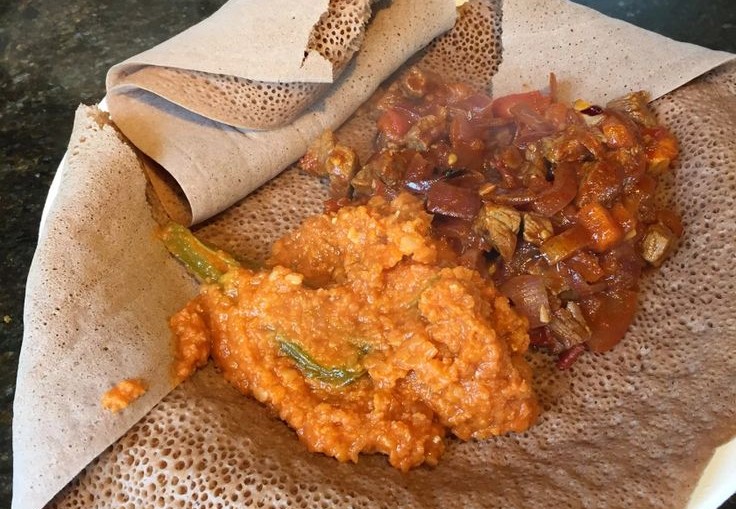How to make Injera at home from scratch: Traditional and modern twists

While the dish is most commonly associated with Ethiopian and Eritrean food, variations of injera are also found in Somali, Cushitic, and Sudanese cuisines.
Injera, the soft, spongy, and slightly tangy flatbread, is a staple in East African cuisine, especially in the Cushitic community.
While the dish is most commonly associated with Ethiopian and Eritrean food, variations of injera are also found in Somali, Cushitic, and Sudanese cuisines.
It is more than just bread, it serves as a plate, a utensil, and an essential part of a communal meal.
Whether you want to make authentic Ethiopian injera or a Kenyan-inspired version, making your own Injera is a recipe away.
Origins of Injera: Different cultural variations
1. Ethiopian and Eritrean Injera
The Ethiopian and Eritrean Injera is made primarily from teff flour, this injera is known for its strong sour taste due to natural fermentation.
It is a key part of meals like Doro Wat (spicy chicken stew) and Misir Wat (lentil stew).
2. Somali Canjeero (Lahoh)
This version is thinner, softer, and slightly sweet. This is because, instead of using 100% of teff, it often includes white flour, ugali flour, or semolina.
Canjeero is commonly eaten for breakfast with honey, sugar, or ghee.
3. Cushitic and Sudanese Variations
Some Cushitic communities use sorghum or barley, instead of using teff. This creates a softer texture. In Sudan, Kisra is a thinner, crepe-like flatbread with a similar tangy taste.
While these variations differ in taste and ingredients, they all share a bubbly texture and are central to their respective cuisines.
What is Teff and why is it used in Injera?
Other Topics To Read
Teff is an ancient grain native to Ethiopia and Eritrea, known for its tiny size, nutritional benefits, and gluten-free nature.
It is high in fibre, protein, and iron, making it a powerhouse ingredient. Because of its fermentation-friendly properties, teff flour creates the signature spongy and sour injera.
In Kenya, you can get teff flour, online, in select supermarkets, organic food stores, East Leigh cereal shops and Ethiopian speciality shops.
If you cannot find teff, try sorghum, barley, or a mix of wheat flour and ugali flour.
- Whole wheat flour – results in a heavier, denser injera
- Sorghum flour – closest in taste and texture to teff
- Barley flour– creates a softer, slightly chewy injera
- White flour and ugali flour mix – best for Somali-style canjeero
How to make Injera
Ingredients
- 2 cups teff flour or alternatives
- 3 cups water
- ½ teaspoon of salt
- 1 teaspoon of dry yeast (to speed up fermentation)
- ½ teaspoon sugar (optional, helps with fermentation)
- Oil for greasing the pan
For a sweeter injera (Somali-style canjeero):
- Add 1-2 tablespoons of sugar to the batter.
- Use a shorter fermentation time (6-8 hours instead of 24).
- Mix in a little coconut milk for natural sweetness.
For a more sour injera (Ethiopian style)
- Ferment for at least 48 hours for a strong tangy flavour.
- Add a little lemon juice before cooking to enhance the sourness.
- Use only teff or sorghum flour, which ferment better than wheat.
Steps to follow
1. In a large bowl, mix teff flour (or alternative), yeast, sugar (if using), and water until smooth. Stir occasionally then cover with a clean cloth.
2. Then ferment the batter for 24-48 hours at room temperature. You can speed up the process by placing the bowl in the sun for 6-8 hours. Warm temperatures help fermentation.
3. To cook the Injera, heat your pan over medium-high heat.
4. Lightly grease the pan, then pour a thin layer of batter in a circular motion. Like you are making a pancake.
5. Cover with a lid and cook for 1-2 minutes until bubbles form and the surface dries. Injera is cooked on one side only.
6. Remove from the pan and let it cool on a clean towel.
7. You can mix in chopped fresh coriander for an extra touch.
8. Serve with spicy lentil stew, grilled meats, or avocado slices for a Kenyan fusion twist.
Top Stories Today
Reader Comments
Trending













































